What does “F61” mean on my Panasonic Stereo System?
- EEmily AcevedoSep 9, 2025
If your Panasonic Stereo System displays “F61”, examine and correct the speaker cable connections.
What does “F61” mean on my Panasonic Stereo System?
If your Panasonic Stereo System displays “F61”, examine and correct the speaker cable connections.
What to do if my Panasonic Stereo System does not respond?
If your Panasonic Stereo System is not responding, it might be due to lightning, static electricity, or another external cause. Disconnect the AC mains lead, and then connect it again. Also, condensation could be the issue. Let the system dry for 1 to 2 hours.
How to reset the ratings password on a Panasonic Stereo System?
If you've forgotten your ratings password on your Panasonic Stereo System, you can reset all settings to factory preset. To do this: 1. Press [4, DVD/CD] and then press [8]. 2. Press [8] on the main unit and [ 10] on the remote control at the same time. “INIT” should appear on the display panel.
What does “NO DISC” mean on my Panasonic SC-VKX80?
If your Panasonic Stereo System displays “NO DISC”, it could be because you haven't inserted a disc or the disc hasn't been inserted correctly. Make sure you put a disc in correctly.
What does “NO PLAY” mean on my Panasonic SC-VKX80 Stereo System?
If your Panasonic Stereo System displays “NO PLAY”, it means the system can't play the disc you inserted. Try changing to a playable disc. This message can also appear if you put in a blank disc or a disc that hasn't been finalized.
What does “OVER CURRENT ERROR” mean on my Panasonic SC-VKX80 Stereo System?
If your Panasonic Stereo System shows “OVER CURRENT ERROR”, the USB mass storage device is using too much power. Change to “DVD/CD” mode, remove the USB mass storage device, and switch off the system.
Why can't my Panasonic Stereo System read my USB device?
If the USB mass storage device or the contents in it cannot be read on your Panasonic Stereo System, it could be due to the format of the USB mass storage device or the contents being incompatible with the system. USB mass storage devices with storage capacity of more than 32 GB may not work in some conditions.
What to do if the tape is stuck in my Panasonic SC-VKX80 Stereo System?
If the tape is stuck and you cannot eject the cassette tape on your Panasonic Stereo System, close the cassette tape deck, switch off the system, and then switch it on again. Press [8/x, STOP/EJECT] again.
How to troubleshoot no power on a Panasonic SC-VKX80?
If there is no power in your Panasonic Stereo System, ensure that you connect the AC mains lead correctly.
What does “DVD U11” mean on my Panasonic Stereo System?
If your Panasonic Stereo System displays “DVD U11”, it indicates that the disc is dirty. Clean the disc.
Position the unit away from heat, moisture, and sunlight. Ensure adequate ventilation to prevent overheating.
Avoid high voltage, DC sources, and wet hands. Ensure correct AC mains lead connection.
Do not open covers or attempt self-repair. Refer servicing to qualified personnel.
Properly install batteries, avoid mixing types, and handle with care to prevent leakage or fire.
Point the remote towards the signal sensor within a 7m range, avoiding obstacles.
Place main speakers symmetrically and subwoofer near the TV, ensuring sufficient clearance.
Use only the provided speakers for optimal sound quality and system compatibility.
Connect TV via video/component cables and position FM antenna for best reception.
Connect front speakers and subwoofer to the main unit using color-coded terminals.
Details on playback, pause, skip, search, and menu navigation buttons.
Covers volume, mute, standby, setup, and TV control functions.
Guides through setting language, TV aspect ratio, and PCM output for optimal performance.
Procedure for accurately setting the 24-hour clock on the system.
Access sources and menus via the START menu for simplified operation.
Steps for opening the disc tray, inserting discs, and initiating playback.
Managing playback with stop, pause, skip, search, and frame-by-frame viewing.
Customizing playback by repeating tracks or creating programmed sequences.
How to play WMA, MP3, JPEG, MPEG4, and DivX files from data discs.
Selecting audio/picture or video options for discs with multiple content types.
Interacting with on-screen menus to select items, adjust settings, and confirm choices.
Connect USB devices to play music, photos, and videos.
Steps for selecting sources and recording audio or video to a USB mass storage device.
List of compatible file formats for audio, video, and still pictures on USB devices.
Instructions for inserting, playing, pausing, recording, and erasing cassette tapes.
Guide on how to prevent accidental recording by covering cassette tape holes.
How to manually tune into stations or use automatic preset scanning.
Methods for saving favorite stations and recalling them using presets.
Configure the system to automatically play music or record audio at set times.
Set the system to turn off automatically after a specified period.
System powers off automatically after 10 minutes of inactivity in certain modes.
Select different surround sound effects for an enhanced listening experience.
Apply preset EQ modes like HEAVY, CLEAR, or SOFT for customized audio.
Adjust Bass, Mid, and Treble levels to personalize sound output.
Enhance low-pitch sound and adjust super woofer levels for deeper bass.
Control echo effects and utilize Karaoke features like vocal cancel and key control.
Play music from portable audio devices by connecting them to the Music Port.
Connect external audio sources like VCRs or DVD players to the Auxiliary input.
Connect to an amplifier via coaxial digital output for high-quality surround sound.
Customize audio language, subtitles, menu language, and playback ratings for discs.
Adjust TV aspect ratio, time delay, still mode, and progressive video output settings.
Set the remote control and main unit to operate specific Panasonic equipment modes.
Set PCM output, Dolby Digital, DTS, and dynamic range for optimal audio signal transmission.
Adjust display language, manage DivX registration, and reset system defaults.
Lists compatible commercial and recorded disc formats including DVD, CD, MP3, and DivX.
Information on PAL/NTSC compatibility and guidelines for creating data discs.
Details on DivX technology, certification, and playing DivX videos.
Process for registering the device to play purchased DivX VOD content.
List of language codes used for selecting audio tracks and subtitles.
Resolves issues like no power, automatic shut-off, and unresponsive controls.
Troubleshoots errors related to disc compatibility, playback, and USB device recognition.
Addresses TV region errors, authorization issues, and remote control malfunctions.
Solves problems with distorted pictures, radio noise, and weak signals.
Resolves USB read errors, slow operation, and cassette tape recording or playback faults.
Instructions for resetting the system's memory to factory default settings.
Technical data on amplifier output power, tuner frequency ranges, and sensitivity.
Details on connectors, USB standards, file system support, and power.
Lists playable disc types, speaker configurations, and frequency responses.
Information on power supply, consumption, dimensions, mass, and operating temperature/humidity.
Position the unit away from heat, moisture, and sunlight. Ensure adequate ventilation to prevent overheating.
Avoid high voltage, DC sources, and wet hands. Ensure correct AC mains lead connection.
Do not open covers or attempt self-repair. Refer servicing to qualified personnel.
Properly install batteries, avoid mixing types, and handle with care to prevent leakage or fire.
Point the remote towards the signal sensor within a 7m range, avoiding obstacles.
Place main speakers symmetrically and subwoofer near the TV, ensuring sufficient clearance.
Use only the provided speakers for optimal sound quality and system compatibility.
Connect TV via video/component cables and position FM antenna for best reception.
Connect front speakers and subwoofer to the main unit using color-coded terminals.
Details on playback, pause, skip, search, and menu navigation buttons.
Covers volume, mute, standby, setup, and TV control functions.
Guides through setting language, TV aspect ratio, and PCM output for optimal performance.
Procedure for accurately setting the 24-hour clock on the system.
Access sources and menus via the START menu for simplified operation.
Steps for opening the disc tray, inserting discs, and initiating playback.
Managing playback with stop, pause, skip, search, and frame-by-frame viewing.
Customizing playback by repeating tracks or creating programmed sequences.
How to play WMA, MP3, JPEG, MPEG4, and DivX files from data discs.
Selecting audio/picture or video options for discs with multiple content types.
Interacting with on-screen menus to select items, adjust settings, and confirm choices.
Connect USB devices to play music, photos, and videos.
Steps for selecting sources and recording audio or video to a USB mass storage device.
List of compatible file formats for audio, video, and still pictures on USB devices.
Instructions for inserting, playing, pausing, recording, and erasing cassette tapes.
Guide on how to prevent accidental recording by covering cassette tape holes.
How to manually tune into stations or use automatic preset scanning.
Methods for saving favorite stations and recalling them using presets.
Configure the system to automatically play music or record audio at set times.
Set the system to turn off automatically after a specified period.
System powers off automatically after 10 minutes of inactivity in certain modes.
Select different surround sound effects for an enhanced listening experience.
Apply preset EQ modes like HEAVY, CLEAR, or SOFT for customized audio.
Adjust Bass, Mid, and Treble levels to personalize sound output.
Enhance low-pitch sound and adjust super woofer levels for deeper bass.
Control echo effects and utilize Karaoke features like vocal cancel and key control.
Play music from portable audio devices by connecting them to the Music Port.
Connect external audio sources like VCRs or DVD players to the Auxiliary input.
Connect to an amplifier via coaxial digital output for high-quality surround sound.
Customize audio language, subtitles, menu language, and playback ratings for discs.
Adjust TV aspect ratio, time delay, still mode, and progressive video output settings.
Set the remote control and main unit to operate specific Panasonic equipment modes.
Set PCM output, Dolby Digital, DTS, and dynamic range for optimal audio signal transmission.
Adjust display language, manage DivX registration, and reset system defaults.
Lists compatible commercial and recorded disc formats including DVD, CD, MP3, and DivX.
Information on PAL/NTSC compatibility and guidelines for creating data discs.
Details on DivX technology, certification, and playing DivX videos.
Process for registering the device to play purchased DivX VOD content.
List of language codes used for selecting audio tracks and subtitles.
Resolves issues like no power, automatic shut-off, and unresponsive controls.
Troubleshoots errors related to disc compatibility, playback, and USB device recognition.
Addresses TV region errors, authorization issues, and remote control malfunctions.
Solves problems with distorted pictures, radio noise, and weak signals.
Resolves USB read errors, slow operation, and cassette tape recording or playback faults.
Instructions for resetting the system's memory to factory default settings.
Technical data on amplifier output power, tuner frequency ranges, and sensitivity.
Details on connectors, USB standards, file system support, and power.
Lists playable disc types, speaker configurations, and frequency responses.
Information on power supply, consumption, dimensions, mass, and operating temperature/humidity.
| RMS output power stereo mode - Front High | 140 W per channel (4 ), 1 kHz, 10% THD |
|---|---|
| RMS output power stereo mode - Front Low | 160 W per channel (3 ), 1 kHz, 10% THD |
| RMS output power stereo mode - Subwoofer Ch | 250 W per channel (8 ), 100 Hz, 10% THD |
| Total RMS stereo mode power | 850 W |
| PMPO output power | 9400 W |
| Preset station - FM | 30 stations |
|---|---|
| Preset station - AM | 15 stations |
| Frequency modulation (FM) range | 87.50 MHz to 108.00 MHz (50 kHz step) |
| Antenna terminals | 75 (unbalanced) |
| Amplitude modulation (AM) frequency range | 522 kHz to 1629 kHz (9 kHz step), 520 kHz to 1630 kHz (10 kHz step) |
| Disc played | DVD, DVD-R, DVD-R DL, DVD-RW, +R/+RW, +R DL, CD, CD-R/RW |
|---|---|
| Picture resolution | between 160 x 120 and 6144 x 4096 pixels |
| Audio output (Disc) channels | 2.1 ch (FL, FR, SW) |
| Front speakers type | 3 way, 3 speaker system (Bass reflex) |
|---|---|
| Front speakers dimensions (W x H x D) | 250 mm x 414 mm x 301 mm |
| Front speakers mass | 5.6 kg |
| Subwoofer type | 1 way, 1 speaker system (Bass reflex) |
| Subwoofer dimensions (W x H x D) | 320 mm x 414 mm x 327 mm |
| Subwoofer mass | 7.5 kg |
| Power consumption in standby mode | 0.3 W (approximate) |
|---|---|
| Power supply for Saudi Arabia and Kuwait | AC 110 to 127 V/220 to 240 V, 50/60 Hz |
| Power supply for others | AC 220 to 240 V, 50/60 Hz |
| Power consumption | 146 W |
| Operating temperature range | 0°C to +40°C |
|---|---|
| Operating humidity range | 35% to 80% RH (no condensation) |
| Dimensions (W x H x D) | 250 mm x 334 mm x 247 mm |
| Mass | 4.1 kg |
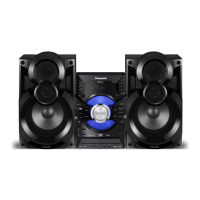

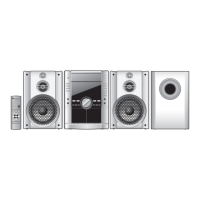




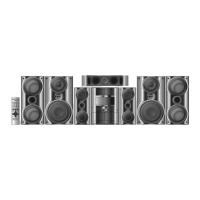
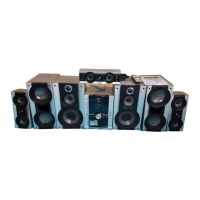
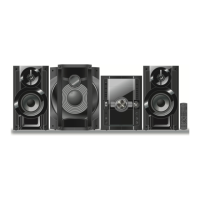
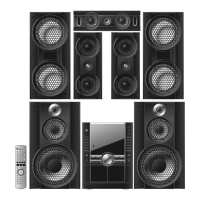

